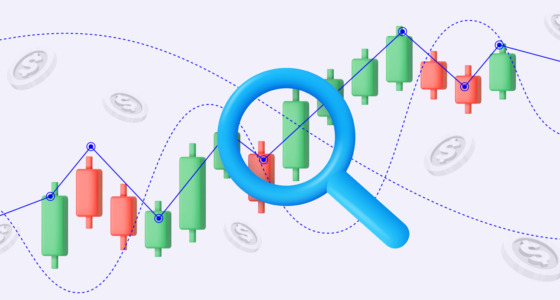

Many novice traders are interested in what scalping is and what strategies best suit this style of trading. Let’s look at how to make scalping trades, the pros and cons of this trading style, and also give tips to novice traders.
What is scalping?
In day trading, scalping is a strategy that aims to profit from small price changes and is best suited for trading options, futures, and equities. Traders who use it are known as scalpers. They make up to several hundred trades a day, believing that small price movements are easier to capture than big ones.
How does stock scalping work?
To become an experienced scalper, you must learn a few principles of scalping:
- Small fluctuations happen more often than large ones. Therefore, the scalper can use many small movements even in relatively calm markets.
- Reducing exposure limits risk. Short-term exposure to the market reduces the likelihood of incorrect forecasts and investment loss.
- Smaller market movements are easier to forecast. For example, it is easier for stocks to move $0.01 than $1.
Scalping can be used as a primary or secondary trading style.
Scalping as a supplementary style
You can use scalping as an additional trading strategy. The most apparent situation to start scalping is when the market is choppy or locked in a tight range. When you are not seeing trends over a longer time frame, moving to a shorter time frame can reveal trends, which can lead you to the scalp.
The second way to add scalping to trades on longer timeframes is to use the “umbrella” concept. It can help maximize profits and improve your cost basis. Let’s look at how to trade according to this concept:
- Open a position for a longer-term trade.
- While the leading trade is developing, identify new setups in a shorter time frame in the direction of the leading trade, enter and exit them using scalping principles.
With specific settings, any trading strategy can be used for scalping. That is, it can be considered not as a trading technique but as one of the risk management methods.

Tips for novice scalpers
If you are new to trading, scalping is not the best strategy. It requires constant monitoring of the market and quick decision-making. However, there are a few tips that can help you.
Trade execution
First of all, you need to learn how to execute orders efficiently. A delayed order can negate your previous profits and even lead to losses. Order execution must be accurate because the profit margin per trade is limited. It requires support systems:
- Direct access trading (DAT). A technology that does not involve a broker’s interventions as you can trade with another client, a specialist on the floor of an exchange, or a market maker.
- Level 2 quotations. It is meant to show you the depth and momentum of the market. With this information, you can determine entry and exit points that reflect the liquidity needed to complete the trade.
Frequency and costs
As a beginner scalper, you should be mindful of costs. Scalping can include up to hundreds of trades in one trading session. As a result of their execution, you will pay too much commission and will remain with lesser profit. Therefore, choosing the right broker with competitive commissions is very important.
Be careful in choosing because not all brokers allow scalping.
Trend trading
Determining the trend and pulse of the market is also crucial for opening more profitable trades. In addition to trend trading, experienced scalpers often apply the countertrend strategy.
Technical analysis
It is also recommended to use technical indicators to receive signals. The Simple Moving Average (SMA), Stochastic, and Bollinger Bands are indicators suitable for such short-term opportunities as multiple chart scalping (e.g., 15-minute chart), relative strength/weakness exit strategy, and moving average ribbon entry strategy.
Pros and cons of stock scalping
Scalping has several advantages that you can leverage on and get a profit. However, it also has some drawbacks that you must consider to reduce the risk of losing your investment.
Pros
The main benefits of scalping include:
- Profitability. With the correct application of the scalping strategy, you can make good profits.
- Limitation of risk. Scalping comes with relatively little risk. Stop-loss points and tight leverage limit losses.
- Independence from fundamental analysis. You mustn’t follow fundamental analysis because it doesn’t matter when trading with only a concise timeframe. For the same reason, you mustn’t study stocks in detail.
- Compatibility with different trading systems. Scalping strategies are most often based on a set of technical criteria, so you can easily automate them within the trading system you are already using.
- Non-directionality of the strategy. Since the scalping strategy is non-directional, you can leverage the market when it is moving in any direction (up or down) and still make a gain.
The futures and options markets are especially receptive to scalping strategy.
Cons
Scalping strategies also have several disadvantages:
- It takes a lot of time. Compared to other trading techniques, scalping involves opening the maximum number of trades in one day (up to even hundreds). Making a profit takes a lot of time and requires a high concentration.
- High transaction fees. Opening many trades come at a high cost, as you have to pay a commission for each transaction fee.
- The strategy needs increased leverage. Scalpers usually have to make a significant deposit to deal with the leverage. However, it can enlarge not only profits but also losses. Since the profit from one trade is small, one significant loss can negate the gain from many successful trades.
Leverage is a form of margin in which a trader borrows from a broker to increase position size.
What are some scalping trading strategies?
Below we will tell you about four popular strategies that experienced scalpers use.
Market-making strategy
This is a scalping strategy in which a trader seeks to profit from the spread by placing an order and an offer for a particular stock simultaneously. As a rule, this scalping trading strategy is successfully applied to static stocks that are traded in large volumes without fundamental price changes.
It is difficult for novice traders to use such a strategy due to high competition. Also, the profit is so negligible that any stock movement against traders’ position could result in a loss more significant than the profit target they had set.
Large lot trading strategy
This scalping strategy involves buying many shares, which are then sold for a profit on a tiny price change. This approach consists in placing an order for several shares (up to several hundred) and watching for a small movement, commonly measured in cents. The asset must be very liquid to make a profit.
Using traditional chart patterns like cups and handles, you can employ the scalping strategy on breakouts or in range-bound trading.
Exit trading strategy
This type of scalping is considered closer to traditional trading methods and works as a hedge against future market movements. When you get the first exit signal close to a 1:1 risk/reward ratio, you need to exit the position. It means ignoring prior price tolerances and exiting with any profit.
Trend following strategy
One of the best scalping techniques is a trend-following strategy, especially when trading using the 1-minute chart. It consists in confirming an already identified trend and following it until it changes direction. If an asset is trending upward, buy an asset. If it is trending downward, sell an asset and profit as the price rises.
Any scalping strategy, be it 1-minute or 5-minutes ones, requires focusing on the charts.
General
Now you know what scalping is and the features of its trading strategies. The trading techniques described above can be an excellent way to profit even in volatile markets. However, you should understand that any strategy, including scalping, cannot guarantee profit. Before using the technique on the real trade, practice on a demo account.









